Proposal and Investigation of an Artificial Intelligence (AI)-Based Cloud Resource Allocation Algorithm in Network Function Virtualization Architectures †
Abstract
1. Introduction
- The study and the investigation of a prediction-based resource allocation algorithm for NFV network environments;
- The study and the investigation of an LSTM-based traffic prediction algorithm with an asymmetric loss function that optimally predicts the traffic values according to the over-provisioning and under-provisioning costs;
- A performance comparison of the proposed solution to other ones proposed in literature and based on predictions with minimization of symmetric loss functions.
2. Intelligence Artificial (AI)-Based Resource Allocation Algorithms in Dynamic Traffic Scenario
2.1. State-of-the-Art
- The instantiation of new Virtual Network Function-Forwarding Graphs (VNF-FG);
- The extension or the reduction of VNF-FGs already instantiated with the addition or the removal of VNFs;
- The variation of required bandwidth of the current VNF-FGs.
- Increasing and decreasing the cloud resources (CPU, memory, disk, etc.) assigned to Virtual Network Function Instances (VNFI) that support VNFs; it is possible to apply horizontal and vertical scaling techniques; the former are based on the increase (scaling in) and decrease (scaling out) of the number of Virtual Machines assigned to each VNFI; the latter are based on the increase (scaling up) or decrease (scaling down) of the cloud resources assigned to the single Virtual Machine in which the VNFI are executing the VNFs.
- Migrating VNFIs to other servers or even other NFVI-PoPs with the application of the above-mentioned scaling techniques.
- An innovative prediction algorithm based on an LSTM recurrent neural network with an asymmetric cusp loss function is proposed;
- The performance of electrical networks is investigated; conversely, resource allocation for Optical NFV networks is investigated in [20];
- Extensive numerical results are reported in which the operational costs of an NFV network with resource allocation based on symmetric and asymmetric LSTM are evaluated respectively;
- New results are presented with respect to [20] in which the resource allocation is not only performed after on the prediction step but the new approach allows for a multi-step prediction and resource allocation.
2.2. Under-Provisioning and Over-Provisioning Costs in Prediction-Based NFV Reconfiguration Algorithms
- A reconfiguration algorithm: it uses the predicted traffic values to reconfigure bandwidth and cloud resource, migrate VNFI, etc.;
- A traffic prediction algorithm: it uses LSTM-based advanced prediction mechanisms to predict the traffic values.
- The Operation Support System/Business Support System (OSS/BSS) may receive the measured real traffic values from the monitored network devices; then it may perform the prediction algorithm to determine the predicted traffic values;
- The Network Function Virtualization Orchestrator (NFVO) receives the predicted traffic values and by applying the reconfiguration algorithm can decide on reallocating bandwidth and cloud resources and/or migrating VNFIs; Virtual Manager Infrastructures and network controllers are used to actuate the reconfigurations decided by the NFVO.
2.3. Prediction-Based NFV Reconfiguration Algorithm
| Algorithm 1Prediction-Based NFV Reconfiguration Algorithm |
|
3. LSTM Prediction Algorithm
- The LSTM prediction layer: it performs the time series prediction by providing the storage of the internal states; we consider the case of a single layer composed by L LSTM Cell Blocks (LCB) referred to as ;
- The feed forward network layer: it evaluates from the output of the last LSTM layer the h steps ahead of the predicted bandwidth values stored in the vector .
4. Numerical Results
- The proposed forecasting solution based on the asymmetric cost function allows for total costs lower than or equal to the one of the MSE-based forecasting solution; the total costs of the two solutions are equal only for w = 1, that is, when the over-provisioning and under-provisioning costs are equal; as a matter of example, the total costs of the MSE and ASYM solutions for w = 0.04 and h = 12 are 134 $ and 96 $ with 28% cost advantage of our proposed asymmetric LSTM prediction solution;
- The better performance in total cost of the asymmetric prediction solution for w lower than 1 is due to the fact that it reduces the resource under-provisioning periods and consequently, the costs due to the QoS degradation.
5. Conclusions
Author Contributions
Funding
Conflicts of Interest
References
- Barakabitze, A.A.; Ahmad, A.; Mijumbi, R.; Hines, A. 5G network slicing using SDN and NFV: A survey of taxonomy, architectures and future challenges. Comput. Netw. 2020, 167, 1–40. [Google Scholar] [CrossRef]
- Pei, J.; Hong, P.; Pan, M.; Liu, J.; Zhou, J. Optimal VNF Placement via Deep Reinforcement Learning in SDN/NFV-Enabled Networks. IEEE J. Sel. Areas Commun. 2020, 38, 263–278. [Google Scholar] [CrossRef]
- Farkiani, B.; Bakhshi, B.; MirHassani, S.A. A Fast Near-Optimal Approach for Energy-Aware SFC Deployment. IEEE Trans. Netw. Serv. Manag. 2019, 16, 1360–1373. [Google Scholar] [CrossRef]
- Yu, Y.; Bu, X.; Yang, K.; Nguyen, H.K.; Han, Z. Network Function Virtualization Resource Allocation Based on Joint Benders Decomposition and ADMM. IEEE Trans. Veh. Technol. 2020, 17, 622–636. [Google Scholar] [CrossRef]
- Eramo, V.; Lavacca, F.G. Computing and Bandwidth Resource Allocation in Multi-Provider NFV Environment. IEEE Commun. Lett. 2018, 22, 2060–2063. [Google Scholar] [CrossRef]
- Karimzadeh-Farshbafan, M.; Shah-Mansouri, V.; Niyato, D. Reliability Aware Service Placement Using a Viterbi-Based Algorithm. IEEE Trans. Netw. Serv. Manag. 2020, 17, 1706–1708. [Google Scholar] [CrossRef]
- Eramo, V.; Miucci, E.; Ammar, M.; Lavacca, F.G. An Approach for Service function Chain Routing and Virtual Function Network Instance Migration in Network Function Virtualization Architectures. IEEE ACM Trnsa. Netw. 2017, 25, 2008–2025. [Google Scholar] [CrossRef]
- Eramo, V.; Lavacca, F.G. Optimizing the Cloud Resources, Bandwidth and Deployment Costs in Multi-Providers Network Function Virtualization Environment. IEEE Access 2017, 7, 46898–46916. [Google Scholar] [CrossRef]
- Karimzadeh-Farshbafan, M.; Shah-Mansouri, V.; Niyato, D. A Dynamic Reliability-Aware Service Placement for Network Function Virtualization (NFV). IEEE J. Sel. Areas Commun. 2020, 38, 318–333. [Google Scholar] [CrossRef]
- Ma, W.; Beltran, J.; Pan, D.; Pissinou, N. Placing Traffic-Changing and Partially-Ordered NFV Middleboxes via SDN. IEEE Trans. Netw. Serv. Manag. 2019, 16, 1303–1317. [Google Scholar] [CrossRef]
- Kim, H.N.; Lee, D.; Jeong, S.; Choix, H.; Yoo, J.; Hong, J.W. Machine Learning-Based Method for Prediction of Virtual Network Function Resource Demands. In Proceedings of the 2019 IEEE Conference on Network Softwarization (NetSoft), Paris, France, 24–28 June 2019. [Google Scholar]
- Schneider, S.; Satheeschandrany, N.P.; Peuster, M.; Karl, H. Machine Learning-Based Method for Prediction of Virtual Network Function Resource Demands. In Proceedings of the 2020 IEEE Conference on Network Softwarization (NetSoft), Ghent, Belgium, 29 June–3 July 2020. [Google Scholar]
- Bega, D.; Gramaglia, M.; Fiore, M.; Banchs, A.; Costa-Perez, X. DeepCog: Optimizing Resource Provisioning in Network Slicing with AI-Based Capacity Forecasting. IEEE J. Sel. Areas Commun. 2020, 38, 361–376. [Google Scholar] [CrossRef]
- Soualah, O.; Mechtri, M.; Ghribi, C.; Zeghlache, D. Online and batch algorithms for VNFs placement and chaining. Comput. Netw. 2019, 158, 98–113. [Google Scholar] [CrossRef]
- Li, B.; Lu, W.; Liu, S.; Zhu, Z. Deep-Learning-Assisted Network Orchestration for On-Demand and Cost-Effective vNF Service Chaining in Inter-DC Elastic Optical Networks. IEEE J. Opt. Commun. Netw. 2018, 10, D29–D41. [Google Scholar] [CrossRef]
- Kong, W.; Dong, Z.Y.; Jia, Y.; Hill, D.J.; Xu, Y.; Zhang, Y. Short-Term Residential Load Forecasting Based on LSTM Recurrent Neural Network. IEEE Trans. Smart Grid 2019, 10, 841–851. [Google Scholar] [CrossRef]
- Farahnakian, F.; Pahikkala, T.; Liljeberg, P.; Plosila, J.; Hieu, N.T.; Tenhunen, H. Energy-Aware VM Consolidation in Cloud Data Centers Using Utilization Prediction Model. IEEE Trans. Cloud Comput. 2019, 7, 524–536. [Google Scholar] [CrossRef]
- Han, J. Data Mining: Concepts and Techniques; Morgan Kaufmann Publishers Inc.: San Francisco, CA, USA, 2005. [Google Scholar]
- Ferrer-Troyano, F.J.; Aguilar-Ruiz, J.S.; Riquelme, J.C. Empirical Evaluation of the Difficulty of Finding a Good Value of k for the Nearest Neighbor. In Proceedings of the 2013 International Conference Computing Science 2003, San Diego, CA, USA, 10–12 December 2003. [Google Scholar]
- Eramo, V.; Catena, T.; Lavacca, F.G.; Giorgio, F.D. Study and Investigation of SARIMA-based Traffic Prediction Models for the Resource Allocation in NFV networks with Elastic Optical Interconnection. In Proceedings of the 2020 22nd International Conference on Transparent Optical Networks (ICTON), Bari, Italy, 19–23 July 2020. [Google Scholar]
- Yilma, G.M.; Yousaf, Z.F.; Sciancalepore, V.; Costa-Perez, X. Benchmarking open source NFV MANO systems: OSM and ONAP. Comput. Commun. 2020, 161, 86–98. [Google Scholar] [CrossRef]
- Trakadas, P.; Karkazis, P.; Leligou, N.; Zahariadis, T.; Vicens, F.; Zurita, A.; Alemany, P.; Soenen, T.; Parada, C.; Bonnet, J.; et al. Comparison of Management and Orchestration Solutions for the 5G Era. J. Sens. Actuator Netw. 2020, 9, 4. [Google Scholar] [CrossRef]
- Eramo, V.; Lavacca, F.G. Proposal and Investigation of a Reconfiguration Cost Aware Policy for Resource Allocation in Multi-Provider NFV Infrastructures Interconnected by Elastic Optical Networks. J. Light. Technol. 2019, 37, 4098–4114. [Google Scholar] [CrossRef]
- SND-Lib. Available online: http://sndlib.zib.de/home.action (accessed on 11 November 2020).
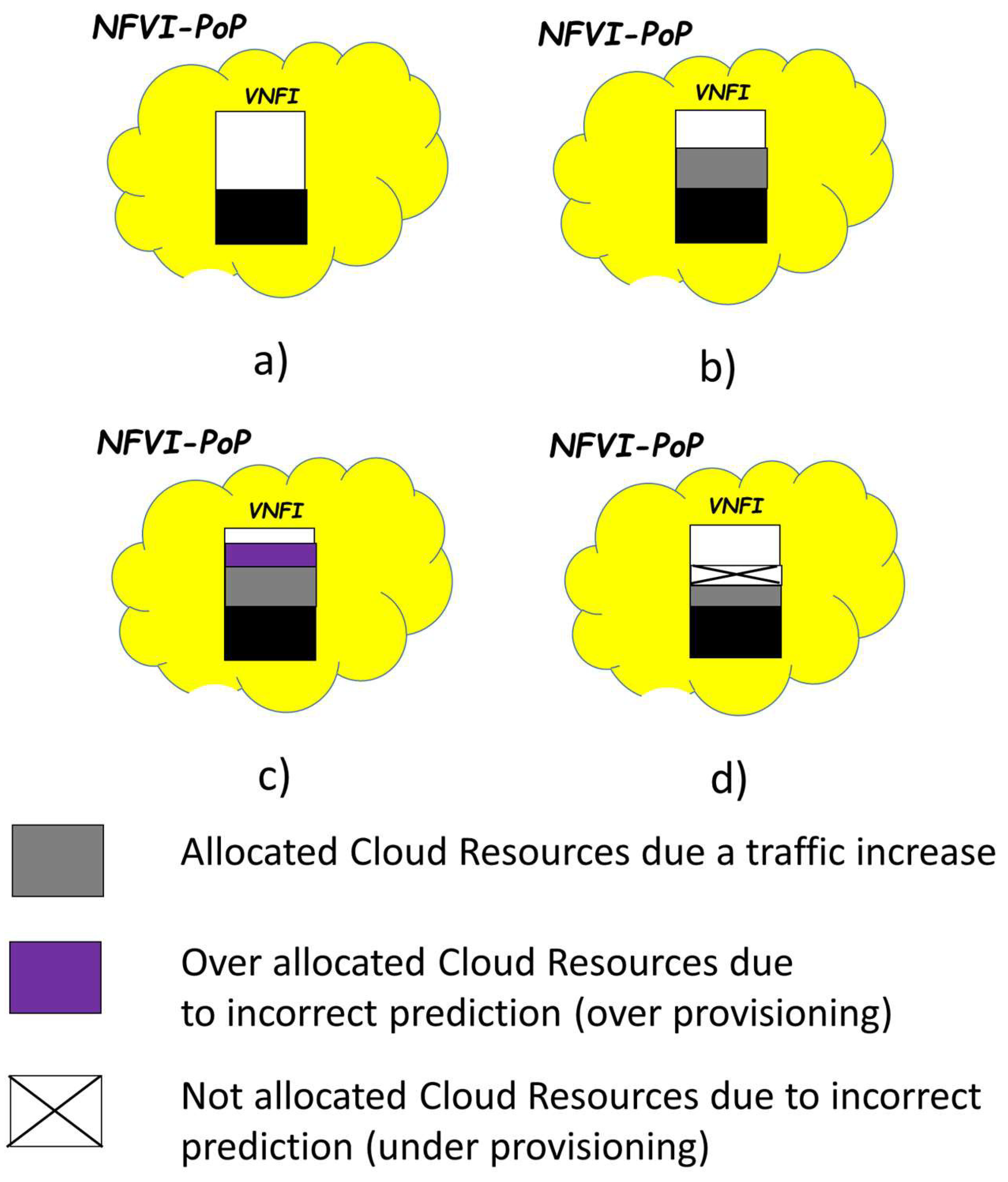

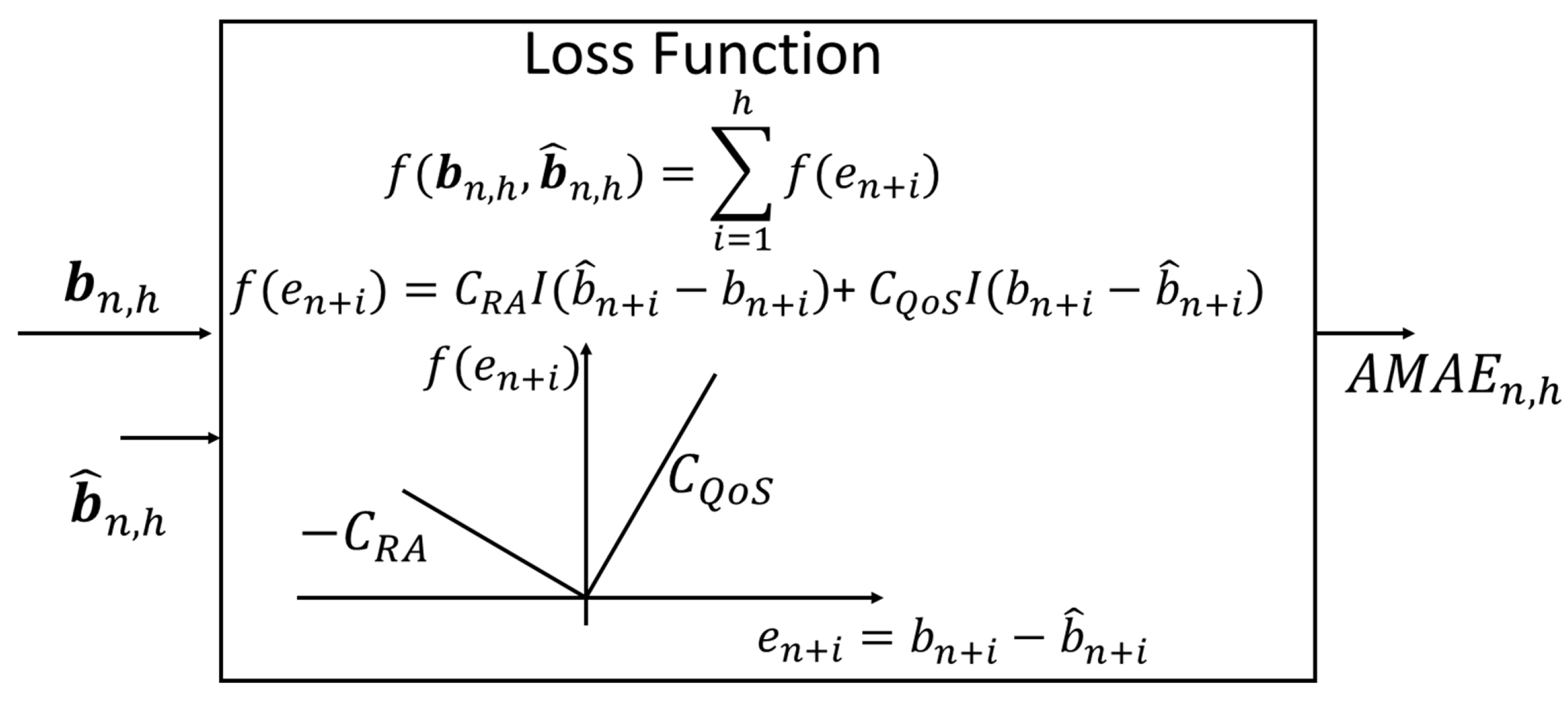
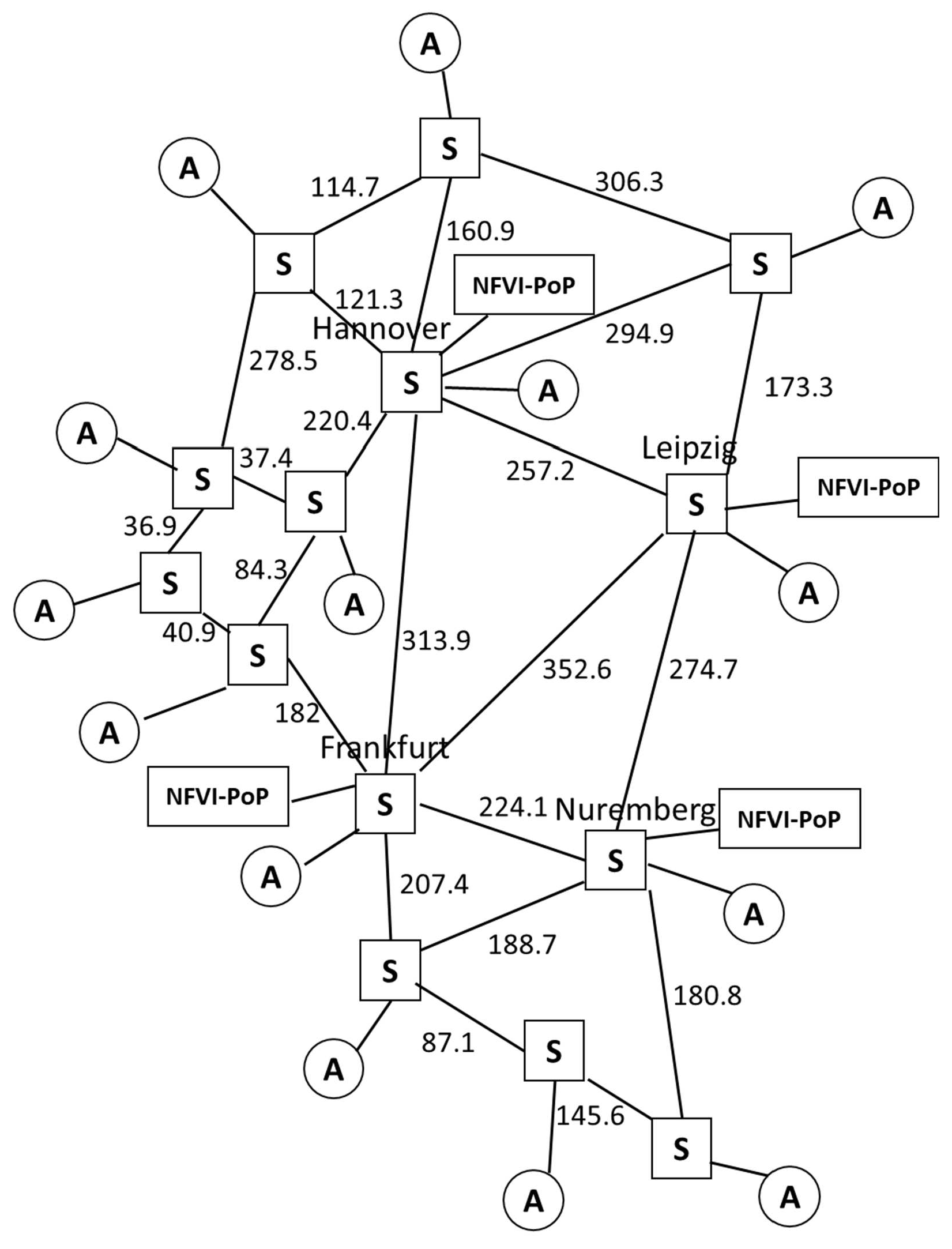
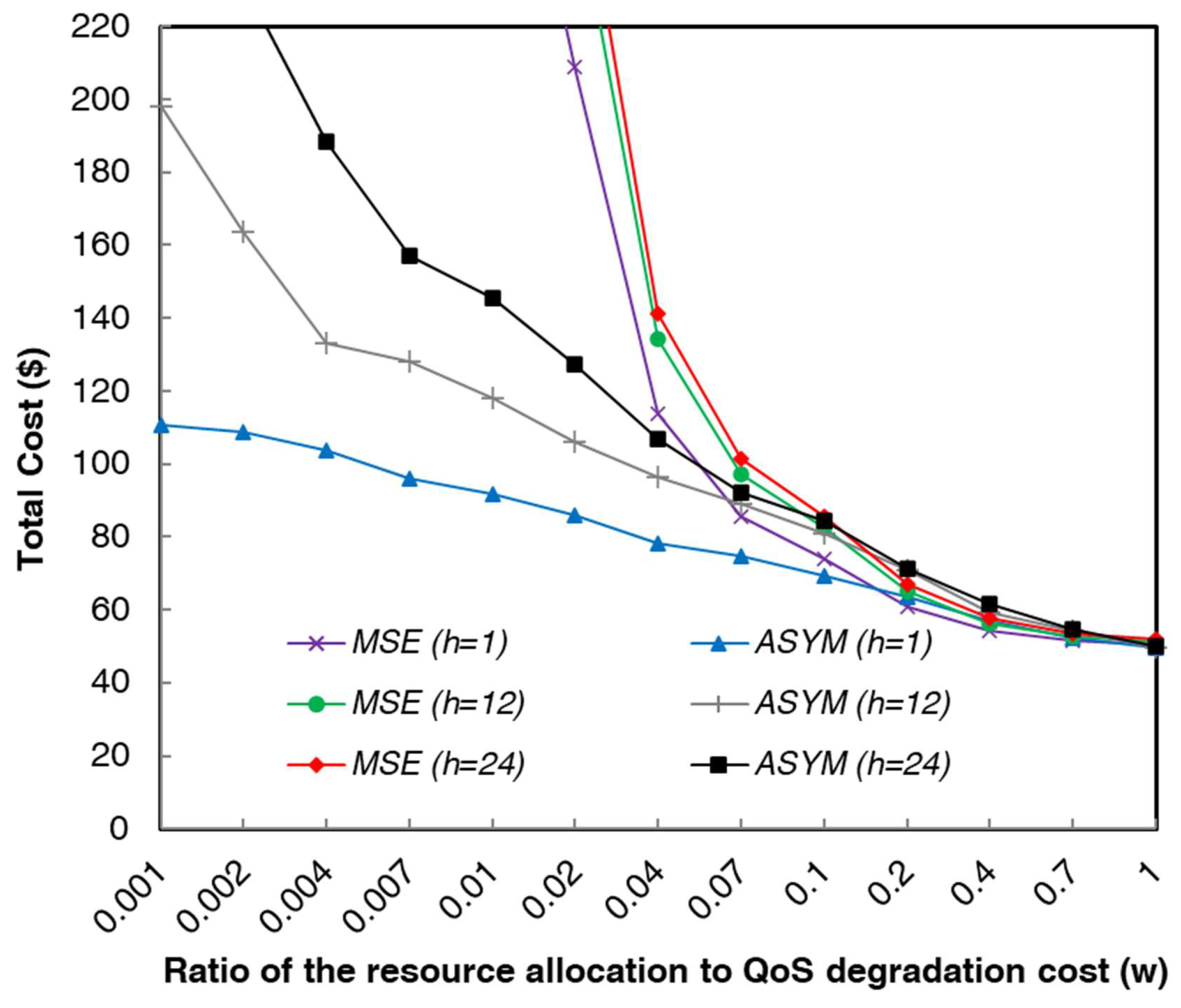
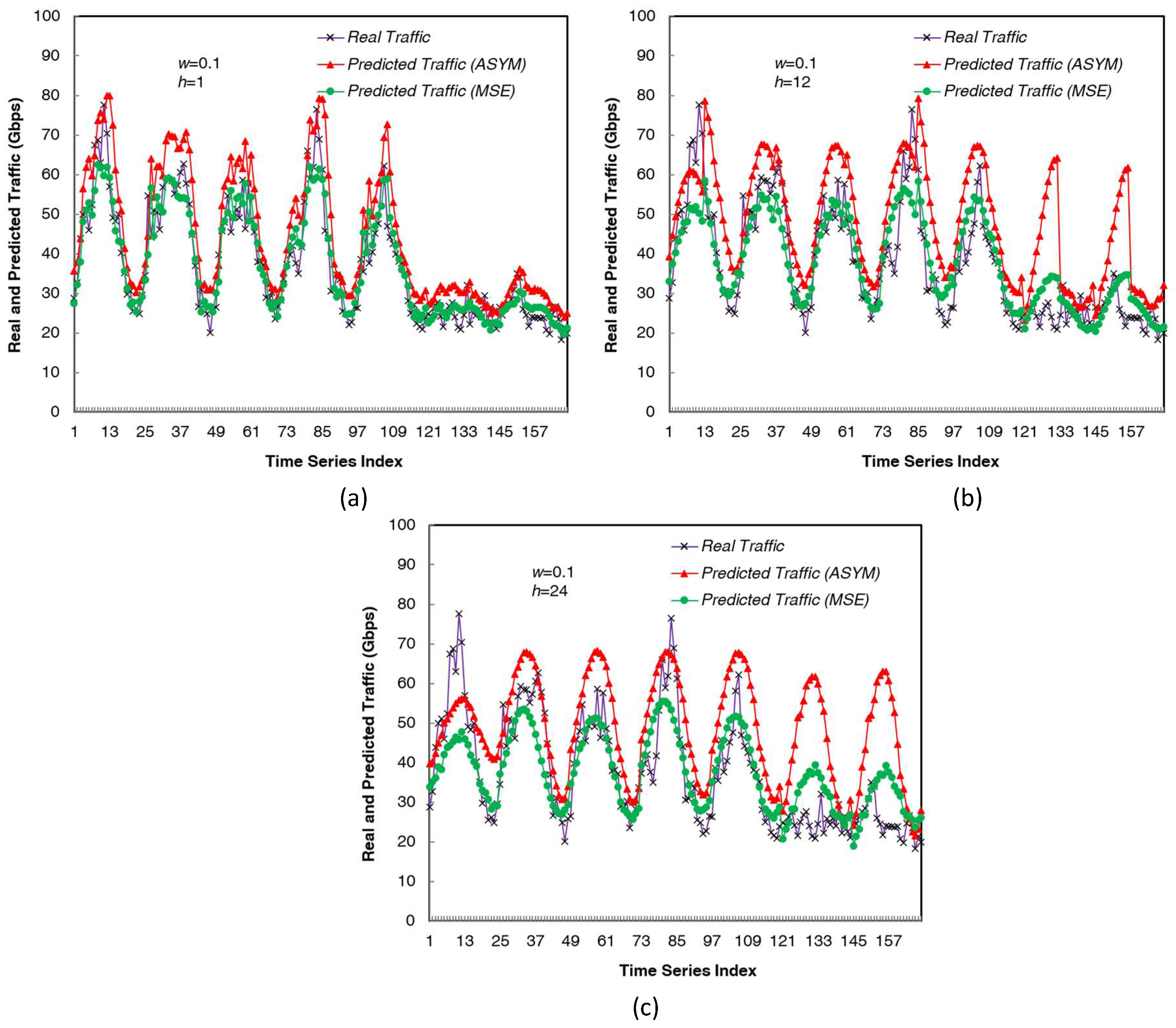
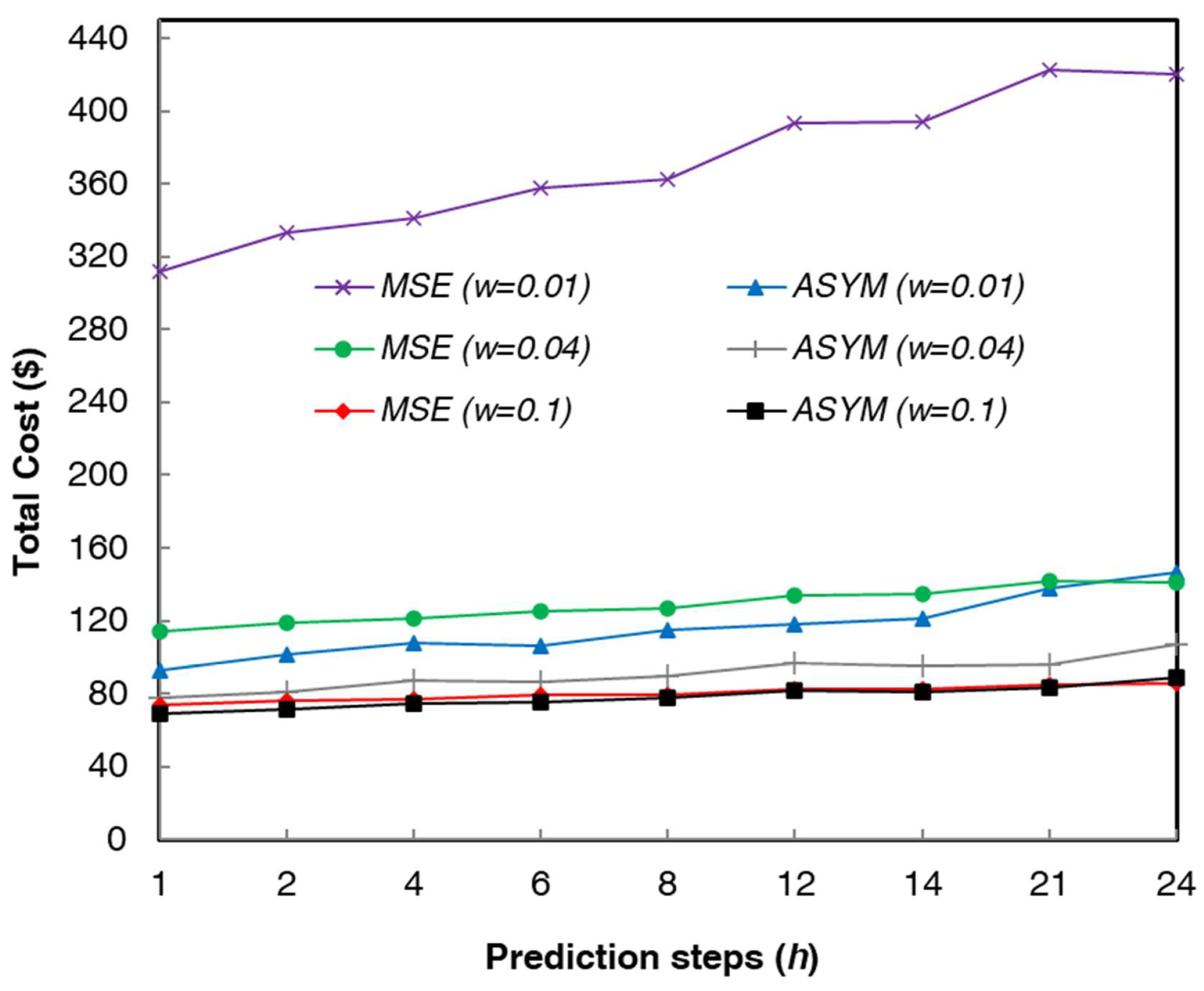
| Work | Prediction Type | Prediction Methodology | Minimized Loss Function |
|---|---|---|---|
| Schneider et al. [12] | Resource | Linear Regression, Support Vector Machine | Symmetric |
| Li et al. [15] | Traffic | LSTM | Symmetric |
| Farahnakian et al. [17] | Resource | Regression Linear, K-Nearest Neighbor Regression | Symmetric |
| Bega et al. [13] | Traffic | Convolutional Neural Networks | Asymmetric |
| Our Proposal | Traffic | LSTM | Asymmetric |
| Sets and Parameters | Definition |
|---|---|
| N | Number of VNF-FGs |
| Bandwidth of the i-th VNF-FG in the j-th TI | |
| V | Set of nodes of the VNFI graph |
| L | Set of links of the VNFI graph |
| Set of nodes of the physical graph | |
| Set of links of the physical graph | |
| Processing capacity required by the node in the j-th TI | |
| Bandwidth of the link in the j-th TI | |
| Cloud Resource Allocation Cost | |
| QoS degradation cost | |
| h | Prediction step |
| Vector of the h bandwidth values for the generic VNG-FG |
| Predicted bandwidth of the i-th VNF-FG in -th TI | |
| Predicted Processing capacity required by the node in -th TI | |
| Predicted bandwidth of the link in -th TI | |
| Vector of the h predicted bandwidth values for the generic VNG-FG | |
| Bandwidth prediction error for a generic VNF-FG in -th TI |
| Link Bandwidth | 30 Gbps | |
| Number of NFVI-PoPs | 4 | |
| Number of cores in any NFVI-PoP | 48 | |
| Average Core Cost | 1 $/h | |
| Core cost unbalancing factor | 1.4 | |
| Time duration of a TI | 1 h | |
| Cloud Resource Allocation cost ($ to be paid for one traffic Gbit) | 0.025 $/Gbit | |
| QoS degradation cost ($ to be paid for one lost traffic Gbit) | 0.00025–2.5 $/Gbit |
Publisher’s Note: MDPI stays neutral with regard to jurisdictional claims in published maps and institutional affiliations. |
© 2020 by the authors. Licensee MDPI, Basel, Switzerland. This article is an open access article distributed under the terms and conditions of the Creative Commons Attribution (CC BY) license (http://creativecommons.org/licenses/by/4.0/).
Share and Cite
Eramo, V.; Lavacca, F.G.; Catena, T.; Perez Salazar, P.J. Proposal and Investigation of an Artificial Intelligence (AI)-Based Cloud Resource Allocation Algorithm in Network Function Virtualization Architectures. Future Internet 2020, 12, 196. https://doi.org/10.3390/fi12110196
Eramo V, Lavacca FG, Catena T, Perez Salazar PJ. Proposal and Investigation of an Artificial Intelligence (AI)-Based Cloud Resource Allocation Algorithm in Network Function Virtualization Architectures. Future Internet. 2020; 12(11):196. https://doi.org/10.3390/fi12110196
Chicago/Turabian StyleEramo, Vincenzo, Francesco Giacinto Lavacca, Tiziana Catena, and Paul Jaime Perez Salazar. 2020. "Proposal and Investigation of an Artificial Intelligence (AI)-Based Cloud Resource Allocation Algorithm in Network Function Virtualization Architectures" Future Internet 12, no. 11: 196. https://doi.org/10.3390/fi12110196
APA StyleEramo, V., Lavacca, F. G., Catena, T., & Perez Salazar, P. J. (2020). Proposal and Investigation of an Artificial Intelligence (AI)-Based Cloud Resource Allocation Algorithm in Network Function Virtualization Architectures. Future Internet, 12(11), 196. https://doi.org/10.3390/fi12110196







